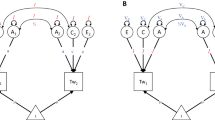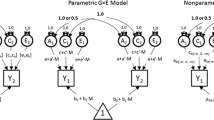Abstract
In prior research we have shown how linear structural equation models and computer programs (e.g., LISREL) may be simply and directly used to provide alternatives for the traditional biometric twin design. We use structural equations and path models to define biometric group differences, we write traditional common-factor models in the same way, and then we take a detailed look at some alternative multivariate and biometric models. We contrast the biometricfactors covariance structure approach used by Loehlin and Vandenberg (1968), Martin and Eaves (1977), and others with the psychometric-factors approach used by McArdle et al. (1980) and others. We use the multivariate primary mental abilities data on monozygotic (MZ) and dizygotic (DZ) twins from Loehlin and Vandenberg (1968) to detail fundamental differences in model specification and results. We extend both multivariate biometric approaches using exploratory and confirmatory multiple-factor models. These comparisons show that each alternative multivariate methodology has useful features for empirical applications.
Similar content being viewed by others
References
Behrman, J., Taubman, P., and Wales, T. (1977). Controlling for and measuring the effects of genetics and family environment in equations for schooling and labor market success. In Taubman, P. (ed.),Kinometrics: Determinants of Socioeconomic Success Within and Between Families, North-Holland, Amsterdam.
Bock, R. D. (1989).Multilevel Analysis of Educational Data, Academic Press, San Diego.
Bock, R. D., and Vandenberg, S. G. (1968). Components of heritable variation in mental test scores, In Vandenberg, S. G. (ed.),Progress in Human Behavior Genetics, Johns Hopkins Press, Baltimore.
Boomsma, D. I., and Gabrielli, W. F. (1985). Behavioral genetic approaches to psychophysiology data.Psychophysiology 22:249–260.
Boomsma, D. I., and Molenaar, P. C. M. (1986). Using LISREL to analyze genetic and environmental covariance structure.Behav. Genet. 16: 237–250.
Cantor, R. M., Nance, W. E., Eaves, L. J., Winter, P. M., and Blanchard, M. M. (1983). Analysis of the covariance structure of digital ridge counts in the offspring of monozygotic twins.Genetics 103:495–512.
Carey, G. (1986). A general multivariate approach to linear modeling in human genetics.Am. J. Hum. Genet. 39:775–786.
Cattell, R. B. (1960). The multiple abstract variance analysis equations and solutions: For nature-nuture research on continoous variables.Psychol. Rev. 67:353–372.
Cattell, R. B. (1982).The Inheritance of Personality and Ability: Research Methods and Findings, Academic Press, New York.
Chamberlain, G., and Grilliches, Z. (1977). More on brothers. In Taubman, P. (ed.),Kinometrics: Determinants of Socioeconomic Success Within and Between Families, North-Holland, Amsterdam.
Crawford, C. B., and DeFries, J. C. (1978). Factor analysis of genetic and environmental correlation matrices.Multivar. Behav. Res. 13:297–318.
DeFries, J. C. (1979). Comment on Fulker's “Some implications of biometrical genetical analysis for psychological research,” In Royce, J. R., and Mos, L. P. (eds.),Theoretical Advances in Behavior Genetics, Sijthoff & Noordhoff, Alphen aan den Rijn, The Netherlands, pp. 381–383.
Eaves, L. J., Martin, N. B., and Eysenck, S. B. G. (1977). An application of the analysis of covariance structures to the psychogenetical study of impulsiveness.Br. J. Math. Stat. Psychol. 30:1–42.
Eaves, L. J., Last, K. A., Young, P. A., and Martin, N. G. (1978). Model-fitting approaches to the analysis of human behavior.Heredity 41:249–320.
Fraser, C. (1979).COSAN User's Guide, Ontarior Institute for Studies in Education, Toronto (Note: Center for Behavioral Studies, University of New England, Armidale, N.S.W., Australia).
Fulker, D. W. (1978). Multivariate extensions of a biometrical model of twin data. In Nance, W. E., et al., (eds.),Twin Research: Psychology and Methodology, Liss, New York, pp. 217–236.
Fulker, D. W. (1979). Some implications of biometrical genetical analysis for psychological research. In Royce, J. R., Mos, L. P. (eds.),Theoretical Advances in Behavior Genetics, Sitjhoff & Noordhoff, Alphen aan den Rijn, The Netherlands.
Fulker, D. W., Baker, L. A., and Bock, R. D. (1983). Estimating components of covariance using LISREL.Data Anal. Commun. Comp. Data Anal. 14:261–281.
Goldberger, A. S. (1978). Pitfalls in the resolution of intelligence inheritance. In Morton, N. E., and Chang, C. S. (eds.),Genetic Epidemiology, Academic Press,New York, pp. 30–45.
Goldsmith, H. H. (1984). Continuity of personality: A genetic perspective.In Emde, R. M., and Harmon, R. J. (eds.),Continuities and Discontinuities in Development,Plenum, New York.
Goldsmith, H. H. (1983). Genetic influences on personality from infancy to adulthood.Child Dev. 54:331–355.
Henderson, N. D. (1982). Human behavior genetics.Annu. Rev. Psychol. 33:403–440.
Horn, J. L. (1986). Intellectual ability concepts. In Sternberg, R. J. (ed.),Advances in the Psychology of Human Intelligence, Erlbaum, Hillsdale, N. J.
Horn, J. L., and McArdle, J. J. (1980). Perspectives on mathematical and statistical model building (MASMOB) in aging research. In Poon, L. W. (ed.),Aging in the 1980s: Contemporary Perspectives, American Psychological Association, Washington, D.C.
Jaspars, J. M. F., and deLeeuw, J. A. (1980). Genetic-environment covariation in human behaviour genetics. In van der Kamp, L. J. Th., Langerak, W. F., and de Gruijter, D. N. M. (eds.),Psychometrics for Educational Debates, Wiley, New York.
Jinks, J. L., and Fulker, D. W. (1970). Comparison of the biometrical genetical, MAVA, and classical approaches to the analysis of human behavior.Psychol. Bull.73:311–349.
Jöreskog, K. G. (1969). A general approach to confirmatory maximum likelihood factor analysis.Psychometrika 34:183–202.
Jöreskog, K. G. (1970). A general model for the analysis of covariance structures.Biometrika 57:239–251.
Jöreskog, K. G., and Sörbom, D. (1979). In Magidson, J. (ed.),Advances in Factor Analysis and Structural Equation Models, Abt Books, Cambridge, Mass.
Kempthorne, O., and Osborne, R. H. (1961). The interpretation of twin data.Am.J. Hum. Genet. 13:320–329.
Lange, K., and Boehnke, M. (1983). Extensions to pedigree analysis. IV. Covariance component models for multivariate traits.Am. J. Med. Genet. 14:513–524.
Loehlin, J. C. (1987).Latent Variable Models: An Introduction to Factor, Path, and Structural Analysis, Erlbaum, Hillsdale, N.J.
Loehlin, J. C. (1978). Heredity-environment analyses of Jenck's IQ correlations.Behav. Genet. 8:(5):415–435.
Loehlin, J. C. (1979). Combining data from different groups in human behavior genetics. In Royce, J. R., and Mos, L. P. (eds.),Theoretical Advances in Behavior Genetics, Sijthoff & Noordhoff, Germantown, Md.
Loehlin, J. C., and Vandenberg, S. G. (1968). Genetic and environmental components in the covariation of cognitive abilities: An additive model. In Vandenberg, S. G. (ed.),Progress in Human Behavior Genetics, Johns Hopkins Press, Baltimore.
Martin, N. G., and Eaves, L. G. (1977). The genetical analysis of covariance structure.Heredity 138:(1):79–95.
Martin, N. G., Eaves, L. J., and Fulker, D. W. (1979). The genetical relationship of impulsiveness and sensation seeking to Eysenck's personality dimensions.Acta Genet. Med. Gemellol. 28:197–210.
Martin, N. G., Jardine, R., and Eaves, L. J. (1984). Is there only one set of genes for different abilities.Behav. Genet. 14:355–370.
Martin, N. G., Boomsma, D. I. and Neale, M. C. (1989). Forward.Behav. Genet. 19:5–7.
McArdle, J. J. (1980). Causal modeling applied to psychonomic systems simulation.Behav. Res. Methods Instrument. 12:193–209.
McArdle, J. J. (1986). Latent growth within behavior genetic models.Behav. Genet. 16:163–200.
McArdle, J. J. (1988). Dynamic but structural equation modeling of repeated measures data. In Nesselroade, J. R., and Cattell, R. B. (eds.),Handbook of Multivariate Experimental Psychology, Vol. II, Plenum Press, New York pp. 561–614.
McArdle, J. J. and Boker, S. M. (1990),RAMpath: Computer software for path diagrams and path analysis. Denver, CO: Data Transforms.
McArdle, J. J., and Goldsmith, H. H. (1984). Structural equation modeling applied to the twin design: Comparative multivariate models of the WAIS.Behav. Genet. 14:609 (abstract).
McArdle, J. J., Goldsmith, H. H., and Horn, J. L. (1981). Genetic structural equation models of fluid and crystallized intelligence.Behav. Genet. 11:607 (abstract).
McArdle, J. J., and Gottesman, I. I. (1987). Some models where independent ≠ different: A response to Plomin & Daniels.Behav. Brain Sci. 10(1):31–32.
McArdle, J. J., and Horn, J. L. (1990). An effective graphic representation for linear structural equation models.Multivar. Behav. Res. (in press).
McArdle, J. J., and McDonald, R. P. (1984). Some algebraic properties of the Reticular Action Model for moment structures.Br. J. Math. Stat. Psychol. 37:234–251.
McArdle, J. J., Connell, J. P., and Goldsmith, H. H. (1980). Structural modeling of stability and genetic influence: Some results from a longitudinal study of behavioral style.Behav. Genet. 10:487.
McDonald, R. P. (1985).Factor Analysis and Related Methods, N.J. Erlbaum, Hillsdale.
McDonald, R. P., and Krane, W. R. (1979). A Monte Carlo study of local identifiability and degrees of freedom in the asymptotic likelihood ratio test.Br. J. Math. Stat. Psychol 32:121–132.
Meredith, W. (1968). Factor analysis and the use of inbred strains. In Vandenberg, S. G. (ed.),Progress in Human Behavior Genetics, Johns Hopkins Press, Baltimore.
Neale, M. C. and McArdle, J. J. (1990). The analysis of assortative mating: A LISREL model.Behavior Genetics,20(2):287–293.
Plomin, R., and Daniels, D. (1987) Why are children in the same family so different?Behav. Brain Sci. 10:37.
Roudabush, G. (1968), Analyzing dyadic relationships. In Vandenberg, S. G. (ed.),Progress in Human Behavior Genetics, Johns Hopkins Press, Baltimore.
Royce, J. R. (1979). The factor-gene basis of individuality. In Royce, J. R., and Mos, L. P. (eds.),Theoretical Advances in Behavior Genetics, Sijthoff & Noordhoff, Alphen aan den Rijn, The Netherlands.
Spearman, D. (1904). General intelligence objectively determined and measured.Am. J. Psychol. 15:201–293.
Tambs, K., Sundet, J. M., and Magnus, P. (1984). Heritability analysis of the WAIS subtests. A study of twins.Intelligence 8:283–293.
Taubman, P. (1978). Determinants of socioeconomic success: Regression and latent variable analysis in samples of twins. In Nance, W. E., et al., (eds.),Twin Research: Psychology and Methodology, Liss, New York.
Thurstone, L. L. (1947).Multiple Factor Analysis, University of Chicago Press, Chicago.
Vandenberg, S. G. (ed.), (1968).Progress in Human Behavior Genetics: Recent Reports on Genetic Syndromes, Twin Studies, and Statistical Advances, Johns Hopkins Press, Baltimore.
Wright, S. (1921). Correlation and causation.J. Agr. Res. 20:557–585.
Wright, S. (1982). On “Path analysis in genetic epidemiology: A critique.”Am. J. Hum. Genet. 35:757–762.
Author information
Authors and Affiliations
Additional information
This research has been supported by grants from the National Institute on Aging (AG02695, AG04704, and AG07137) to McArdle, and a Research Career Development Award (HD00694) to Goldsmith.
Rights and permissions
About this article
Cite this article
McArdle, J.J., Goldsmith, H.H. Alternative common factor models for multivariate biometric analyses. Behav Genet 20, 569–608 (1990). https://doi.org/10.1007/BF01065873
Received:
Accepted:
Issue Date:
DOI: https://doi.org/10.1007/BF01065873




